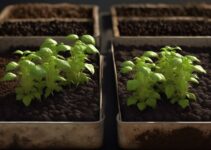If you've ever struggled with cannabis seed germination, you're not alone. In fact, studies have shown that up to 15% of cannabis growers face difficulties in getting their seeds to sprout. But fear not, because there are six essential scarification methods that can significantly increase your chances of successful germination. Whether you're a novice or experienced grower, understanding these techniques is crucial for maximizing your cannabis plant's potential. So, let's explore these essential methods and how they can revolutionize your germination process.
Key Takeaways
- Scarification is a beneficial process for promoting germination in cannabis seeds with tough outer shells.
- Mechanical scarification involves scratching or nicking the seed coat to create small openings, while acid scarification treats seeds with strong acids to create nicks or scratches.
- Both methods soften the seed coat, facilitating water absorption and promoting germination.
- Precision, caution, and appropriate tools are necessary to minimize potential seed damage and infection risk during scarification.
Understanding Scarification for Cannabis Seeds
If you frequently encounter cannabis seeds with hard outer shells that hinder germination, understanding scarification can significantly improve your success rate. Scarification is a process used to promote germination by breaking the hard outer shell of the seed. This treatment can be particularly beneficial for older seeds or those with tough outer coatings. There are two main scarification techniques: chemical and mechanical. Chemical scarification involves treating the seeds with specific chemicals to mimic natural processes that weaken the seed coat. On the other hand, mechanical scarification physically damages the seed's outer shell, allowing water to penetrate more easily and speeding up the germination process. Understanding scarification is crucial for evaluating the quality of seeds and determining the most suitable scarification method. It's essential to consider the equipment needed for scarification, as this can vary depending on the chosen technique. By understanding the principles and techniques of scarification, you can significantly increase the germination success of cannabis seeds with hard outer shells.
Types of Scarification Techniques
When considering types of scarification techniques, it's important to explore mechanical scarification and acid scarification. Mechanical scarification involves physically damaging the seed's outer shell, while acid scarification treats seeds with specific acidic solutions. Both methods serve to soften the seed's outer shell, facilitating water absorption and promoting germination.
Mechanical Scarification
Mechanical scarification encompasses the physical alteration of a cannabis seed's outer shell to facilitate the process of germination. This technique involves the deliberate removal of a small portion of the outer seed coat to aid in water absorption and initiate the germination process. Common methods include scratching the seed coat with a scalpel or nicking it with a sharp blade to create small openings. Another approach is to carefully file the outer shell using a nail file to create abrasions. It is crucial to exercise caution during mechanical scarification to prevent damaging the delicate embryo inside the seed. By simulating natural environmental friction, mechanical scarification can significantly enhance germination techniques, particularly for older seeds with hard outer shells.
Acid Scarification
A key component of acid scarification as a cannabis seed germination technique is the utilization of acidic substances to break down the hard outer shell, enhancing water absorption and expediting the germination process. Acid scarification involves treating the seeds with strong acids, such as sulfuric acid, to create nicks or scratches on the seed coat. This process aims to facilitate water absorption and promote faster germination by softening the seed coat. When using acid for scarification, extreme caution must be exercised due to the corrosive nature of these substances. It can be an effective technique for promoting successful germination of cannabis seeds. Prioritize safety and carefully follow recommended procedures when handling acidic substances to ensure successful seed treatment. Always source seeds from reputable sources and consider using a hydrogen peroxide solution or a scalpel to remove the seed coat.
Difficulties in Cannabis Seed Sprouting
Cannabis seed germination can present challenges due to the protective outer shell that impedes the sprouting process. This protective layer, known as the seed coat, can vary in thickness and hardness among different cannabis seeds. When dealing with high-quality cannabis seeds, difficulties in germination may arise due to the seed coat's resistance to moisture and the embryo's emergence. Here are the main difficulties in cannabis seed sprouting:
- Variability in germination rates: The protective seed coat can lead to inconsistent germination rates, making it difficult to predict when seeds will sprout.
- Control of moisture levels: The impermeable nature of the seed coat can make it challenging to maintain optimal moisture levels for germination.
- Time-consuming process: With untreated seeds, germination may take longer or be less successful, resulting in a longer overall germination process.
Understanding these difficulties is crucial for achieving synchronized germination and promoting consistent results when cultivating cannabis.
Risks of Marijuana Seed Scarification
When scarifying marijuana seeds, it's crucial to be aware of the potential risks involved. Improper scarification can lead to damage to the embryo inside the seed, diminishing its viability. Additionally, there is a risk of introducing contaminants that could hinder the germination process.
Potential Seed Damage
Using excessive force or chemical treatment during scarification may lead to reduced germination rates, potential contamination, and irreversible damage to the seed coat. Improper scarification techniques can open the seeds to pathogens, leading to contamination and reduced viability. Excessive scarification can cause irreversible damage to the seed coat, hindering successful germination. Furthermore, inadequate precision during scarification can harm the seed's ability to absorb water, impacting its ability to sprout. It is crucial to follow precise guidelines and use appropriate tools to minimize the risks of potential seed damage. The Department of Plant Sciences emphasizes the importance of proper scarification methods to ensure the health and viability of the seeds.
Infection Risk
To minimize the risk of infection during the scarification process, it is essential to employ proper sterilization techniques for equipment and ensure a sterile environment. When scarifying cannabis seeds, it's crucial to be mindful of the infection risk and take preventive measures. The use of sterile tools and a clean workspace is imperative to avoid introducing pathogens that can compromise the seeds. Chemical scarification methods may carry a higher risk of contamination compared to mechanical methods, making it essential to exercise caution. Below is a table outlining key factors to consider for minimizing infection risk during the scarification process:
| Factor | Consideration |
|---|---|
| Sterilization | Disinfect equipment with sodium hypochlorite solution |
| Workspace | Maintain a sterile environment for scarification |
| Monitoring | Carefully observe scarified seeds for signs of infection |
| Technique | Remove the seeds using a scalpel for precision |
| Environment Control | Control humidity level and maintain an ideal temperature |
Adhering to these considerations can significantly reduce the risk of infection during the scarification process, promoting successful in vitro seed germination.
Impact on Germination
Scarification of marijuana seeds carries inherent risks, including potential damage to the seed embryo if not performed carefully during the process. When considering the impacts on germination, it's important to recognize the following:
- Chemical scarification may pose risks if not properly diluted or handled without protective gear.
- Mechanical scarification carries the risk of damaging the seed embryo if not performed carefully.
- Over-scarification can weaken the seed and hinder germination success.
To mitigate these risks and improve germination, it's vital to exercise caution and precision when scarifying cannabis seeds. When germinating cannabis, ensure you place your seeds in potting soil that is kept consistently even moist to support healthy germination and minimize the potential negative impacts of scarification.
Efficient Seed Scarification Methods
Efficiently breaking the hard outer shell of cannabis seeds can be achieved through chemical or mechanical scarification methods, which promote water penetration and accelerate the germination process. Chemical scarification involves soaking the seeds in specific solutions like sulfuric acid for a precise duration. This breaks down the tough outer coat, allowing water to permeate the seed more easily. Mechanical scarification, on the other hand, requires careful handling. Using sandpaper or a small file, gently rub the seed coat to create small abrasions, ensuring water absorption. When scarifying seeds, make sure to carefully remove any damaged or malformed seeds to maintain consistency in treatment. Synchronized germination is crucial for efficient cultivation. Additionally, handle the seeds gently to avoid damaging the inner embryo, which is vital for successful germination. By using efficient seed scarification methods, you can promote faster and more uniform germination, ultimately leading to healthier and more productive cannabis plants.
Considerations for Cannabis Seed Scarification
When considering cannabis seed scarification, it is essential to carefully assess the quality of the seeds and practice precise cutting techniques to ensure effective softening of the outer shell for improved water absorption. Here are some key considerations to keep in mind:
- Seed Quality Assessment: Before scarifying the seeds, thoroughly inspect them for any signs of damage, mold, or deformities. Only select high-quality seeds to sprout effectively.
- Hydrogen Peroxide Soak: Consider using a hydrogen peroxide solution to soak seeds before scarification. This can help to disinfect the seeds and soften their outer shell, facilitating the scarification process.
- Planting in a Soaking Wet Growing Medium: After scarifying the seeds, plant them in a growing medium that is soaking wet. This will ensure that the seeds have ample moisture for germination and early growth.
Frequently Asked Questions
What Are Three Techniques for Scarifying Seeds?
To scarify seeds, consider mechanical abrasion to break the seed coat, enhancing seed viability and breaking dormancy. Additionally, chemical scarification can improve germination rates. These techniques are essential for maximizing germination efficiency.
Should You Scarify Cannabis Seeds?
Yes, you should scarify cannabis seeds. It promotes faster germination and helps manage environmental conditions. While it requires careful handling, the benefits of improved efficiency and search for new cultivars outweigh the drawbacks. Expert opinions support its effectiveness.
Do Cannabis Seeds Require Stratification?
Cannabis seeds do not require stratification for germination. This cold treatment benefits some plant species, but not cannabis. Instead, seed treatment methods like scarification and pre-soaking are more critical in the germination process for cannabis seeds.
What Are the Methods of Scarification?
To soften the seed coat, mechanical scarification physically damages it. Acid scarification and heat scarification are other methods. The scarification process enhances seed viability, promoting successful germination and growth of cannabis seeds.





